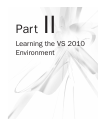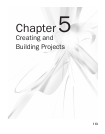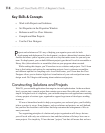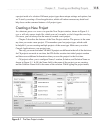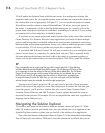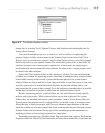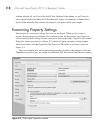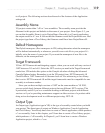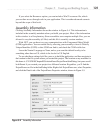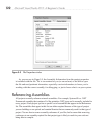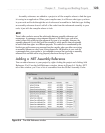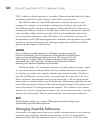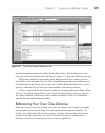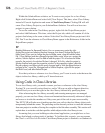
Chapter 5: Creating and Building Projects 119
to all projects. The following sections describe each of the features of the Application
settings tab.
Assembly Name
VS projects create either *.dll or *.exe assemblies. The assembly name provides the
filename for this project and defaults to the name of your project. From Figure 5-3, you
can see that Assembly Name is set to ProjectDemo. Since this is a Console application,
the output would be a *.exe. It follows that the filename would be ProjectDemo.exe. Had
the project type been a Class Library, the filename would have been ProjectDemo.dll.
Default Namespace
The Default namespace (Root namespace in VB) setting determines what the namespace
will be defined automatically as whenever you add a new code file to your project. It’s
initially set to the name of your project. If you want the namespace of new files to be
different, set the namespace here.
Target Framework
VS has .NET Framework multitargeting support, where you can work with any version of
.NET between v2.0 and v4.0. Select the .NET version you need in the Target Framework
combo box. VB includes this option on the Compile tab when clicking the Advanced
Compile Options button. Remember to set the VB project from .NET Framework 4.0
Client Profile to .NET Framework 4.0 because later we’ll be referencing a class library
that is set to .NET Framework 4.0 and the target frameworks must be compatible for one
assembly to reference another.
Since you can have multiple versions of .NET on the same machine as VS 2010,
you can switch freely between different projects that use different .NET versions. This
is particularly useful if you’re a consultant working on different projects with different
versions or if you’re providing maintenance support on older versions of a product while
doing active development work in a different project using .NET 4.0.
Output Type
An Output type (Application type in VB) is the type of assembly created when you build
your project. The three types of output are Windows Application, Console Application,
and Class Library. You already know how to create a Console application, which produces
a *.exe assembly. Later in this chapter, you’ll learn how to create a Class Library project,
which produces a *.dll assembly. In Chapter 8, you’ll learn how to create a Windows
Application project, which is a *.exe.



